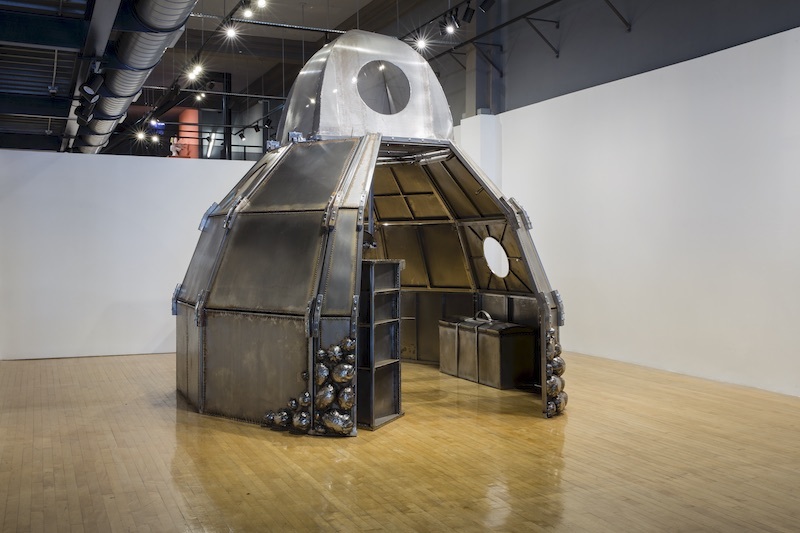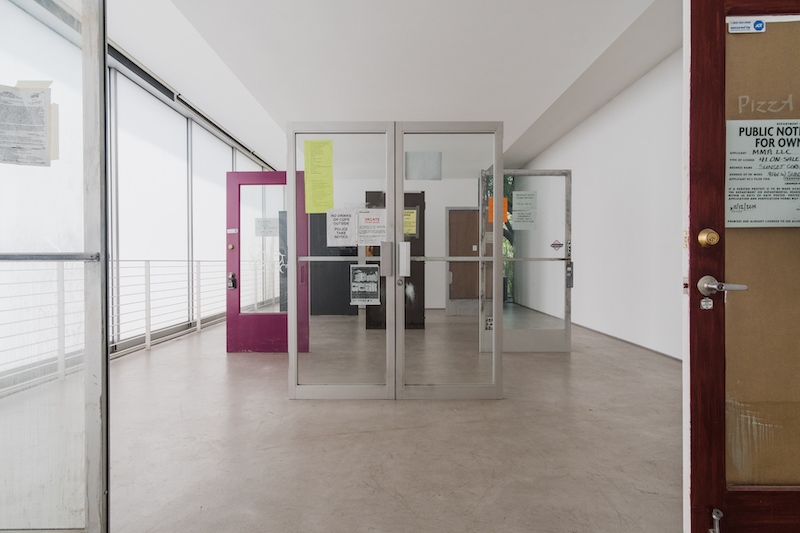In Plain Sight: Exhibiting Untold Stories
Review of In Plain Sight at Henry Art Gallery.
Written by TeenTix Newsroom Writer Taylar Christianson and edited by Teen Editor Tova Gaster.

If you visit the Henry Art Gallery during the next five months, the first thing you’ll see as you walk towards the galleries is a large, color-changing neon sign stating “Education Should Be Free.” This bright and vibrant piece by Andrea Bowers sets the tone for the expansive and exciting exhibition ahead. In Plain Sight showcases 14 artists from around the world in a single exhibit, which occupies the whole museum but won’t take your entire day to explore (unless you want it to!).
The title of the exhibition is taken from the phrase “hidden in plain sight”—something that exists just under the surface but is invisible to the eye. In Plain Sight removes the “hidden” element of the phrase and aims instead to bring forward narratives, communities, and histories that are often invisible in mainstream American culture. The artists address these stories and identities in their art, and work to “tell previously unknown stories, to speak for voices that have been undervalued or deliberately silenced, to reveal aspects of our public narratives that have been obfuscated, and to reimagine histories for the future” (The Henry website).
The works displayed in In Plain Sight span a range of mediums, including photography, painting, video, sculpture, audio, and neon/laser art. Alison O’Daniel’s The Tuba Thieves, which explores the transfer of information for those living with hearing loss and deafness, is an immersive film project that draws the viewer into a slow and surreal world of rain, stargazing, and humming plants. The piece takes its title from a string of tuba robberies from high school marching bands in Los Angeles in 2011, which O’Daniel related to her experience of being hard of hearing— having to fill in gaps in conversation as if an important instrument was missing.

Beatriz Cortez’s Memory Insertion Capsule is a striking metal space capsule arranged for viewers to walk through. Cortez uses sculpture (metal rocks on the outside of the capsule evoke Central American architecture) and video (a small screen shows archival materials related to the United Fruit Company, notorious for its corporate colonization of Central America) to educate viewers in a process Cortez describes as implanting memories of colonial injustice, as if the viewer had experienced that history themself.
One of the largest pieces is an iteration of sculptor Oscar Tuazon’s Water School, an installation which several U.S. cities host a version of. The large wooden platform, leading viewers up its steps and through its bookshelves, is intended to educate its visitors about the relationship between water and the communities of people who live near it—something certainly relevant to Seattle’s location on Puget Sound.
Though the goal of In Plain Sight is to showcase narratives that aren’t typically given platforms, the physical display of the pieces undermines this slightly. The text panels that accompany the pieces don’t provide context or talk about artist intent, but simply state the basic information: title, artist, and materials used. This obscures the meaning of the piece and places responsibility on the viewer to interpret the work based on what they see or hear in the piece itself, which is sometimes detrimental to the casual observer’s experience.

When I visited the exhibition, I was stumped by a gallery room full of Fiona Connor’s untitled works, which appear to be just pieces of painted plywood hanging on the walls. Someone I know who works at the Henry happened to come into the room, and they quickly explained that the pieces of wood were replicas of doors and message boards from closed-down public spaces in Los Angeles, like gay bars and dog parks. This simple background information changed my entire perception of the works’ significance.
This trend holds true for several of the pieces in In Plain Sight, so viewers might want to do a little preparation and research to get the most out of the pieces exhibited. Some simple resources to learn about the artists and their work before you go (or to have open on your phone while you’re in the gallery) can be found here, here, and on the Henry’s website.
In Plain Sight may take a little extra effort on the viewer’s part, but it’s well worth it to experience such a vibrant collection that contains a wide range of identities expressed through different mediums. Part of the Henry’s mission as a gallery is to provide a platform for marginalized artists, emerging artists, and others who may have limited opportunity to be exhibited elsewhere. In Plain Sight exemplifies this aim, bringing together artists from around the country and the world to unearth their own histories, communities, and narratives that are often obscured from the public view.
In Plain Sight is on display at Henry Art Gallery from November 23, 2019 - April 26, 2020. For event info see HERE.
Lead photo caption: Hayv Kahraman. The Audience. 2018. Photo by Robert Wedemeyer.
The TeenTix Newsroom is a group of teen writers led by the Teen Editorial Staff. For each review, Newsroom writers work individually with a teen editor to polish their writing for publication. The Teen Editorial Staff is made up of 6 teens who curate the review portion of the TeenTix blog. More information about the Teen Editorial Staff can be found HERE.
The TeenTix Press Corps promotes critical thinking, communication, and information literacy through criticism and journalism practice for teens. For more information about the Press Corps program see HERE.

